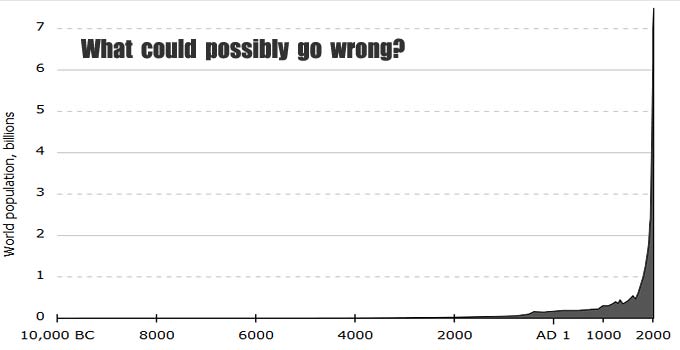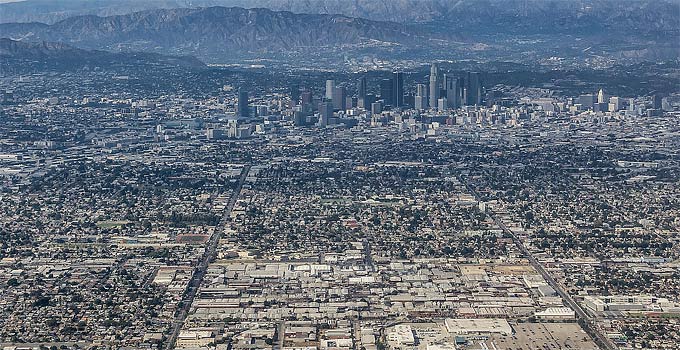World Population Growth and Natural Balance

World population in 2019 is right around 7.7 billion as of this writing.
Current population growth rate is about 83 million per year.
100 years ago, world population was just 1.6 billion.
100 years before that, 1 billion.
2,000 years ago, 200 million.
2000 BC, 27 million.
It took all of human history until around the year 1800 for world population to reach one billion.
The second billion was achieved in only 130 years (1930).
The third billion in less than 30 years (1959).
The fourth billion in 15 years (1974).
The fifth billion in only 13 years (1987).
The sixth billion in 12 years (1999).
The seventh billion in 12 years (2011).
And like I said, today we’re at 7.7 billion (2019).
In 1970, there were roughly half as many people in the world as there are now.
The world population graph shown above might trigger a sense of alarm. Maybe it should.
Human Population Explosion
Why or how has human population grown in such a ‘hockey stick’ upright curve – seemingly straight up when viewing from a wide timeline?
In my estimation there are a number of reasons.
But first, fathom this:
The Exponential function
While world population growth may not be exactly along the exponential function, it does seem to resemble it.
Here’s a great example of how it works. I first read this years ago from an article on PeakProsperity.com and I will summarize it for you:
You’re sitting up in the upper ‘nose bleed’ section of a sports stadium. Imagine that the stadium is ‘water tight’.
A single drop of water lands on the field at 1PM. If one minute later 2 drops of water land on the field, and then one minute after that 4 drops, and so on (doubles every subsequent minute), how long until the stadium completely fills with water?
Probably a very long time, right? And you would have plenty of time to get out as you notice the water slowly rising, right?
The first drop of water lands right in the middle of the field at 1 PM. You only have until 1:49 PM before you must swim or drown!
It apparently would take less than 50 minutes to fill the entire stadium.
But here’s where it gets more interesting…
At what time do you think the stadium is still 93% empty?Answer: At 1:45 PM the stadium is still 93% empty. You only have 4 more minutes to get out!
That’s the thing with exponential growth. It all looks fairly benign until suddenly, it’s not!
Okay, I’m not suggesting that world population growth is going to fill the planet in ‘4 minutes’ as in the analogy above.
I do believe that population growth will become self limiting to the extent that resources and technology allow.
We may be within that approximate time right now. Current population growth rate projections suggest that growth will remain approximately 12 years per billion. After 2023 the expectation is growth will slow down to 14 years per billion. Then 18 years.
source (Wikipdeia ‘Population Growth’)
How and Why So Many People in the World?
In my estimation, primary factors include modern energy (oil), the industrial revolution growth period, mass agriculture, and modern healthcare and medicine.
Massive Agriculture
Modern mass agriculture has enabled enormous amounts of food production to feed the population.
Today in the United States, fewer than 1 percent claim farming as an occupation and only 2 percent of Americans live on a farm.
source: The Dwindling Percentage Of American Family Farms
Of the 1% of farmer occupations, only 9% (of the 1%) represent 75% of ALL FARM REVENUE in the United States. This illustrates how few farms provide the majority of production here in the U.S.
Long gone are the days of many family farms dotted across the countryside. Today, “all our eggs are in one basket” so to speak.
Additionally, today we can acquire food from all over the world.
Distribution Channels
We’ve gone from horse and wagons to railroads, container ships, trucks, and airplanes.
Cheap energy and technology have enabled vast distribution channels.
There is a constant supply of goods flowing through numerous supply channels across the land, sea, and air. Spanning the globe.
This enables millions upon millions of people to live in highly densely populated regions.
When the Trucks Stop, it’s Over
The regions themselves cannot support themselves. However distribution channels flow into these populous regions like blood flowing through veins.
Read more: Cities are Artificial
Modern Medicine
The discovery of antibiotics has been a huge factor in the field of medicine and people living longer. It wasn’t until the 1940’s when Penicillin went into mass production.
Think about it. It wasn’t that long ago when an ordinary cut could potentially infect and kill you.
Modern hospitals, healthcare and medicine have greatly increased the life expectancy of humans and have aided in the growth of human population.
The Survival Medicine Handbook
Energy
There’s no way any of this could have happened without the mass availability of energy. Oil is today’s primary source. Petroleum is the basis for so many of our products.
Electricity is also the lifeblood of our modern existence. I shouldn’t have to explain the multitude of ways that our modern life is hinged with electricity.
The Natural Balance of Human Population
I wonder what would be the natural balance of human population without today’s modern inventions, technologies, and global distribution?
I don’t know the answer because there are so many variables beyond what I’ve mentioned.
However I do ask the question to emphasize that a majority of today’s population would not exist without external systems that keep us alive.
One guess at a number might be somewhere in the neighborhood of 1 billion globally.
Back in the 1800’s before most of today’s modern innovation and technology, the human population was in the 1 billion range. Many or most people were fairly self sufficient. There were cities of course but it was before the major population spike and before today’s mega cities…
Systemic Risk & Preparedness
In conclusion, I’m not posting this as a notion of ‘peak population’.
Rather I am attempting to use the human population explosion to suggest that there are external systems that must continue to function to keep the 7+ billion people alive.
There are inherent risks within the global population system. There are actions that we can take to lessen our dependence on those systems.
Doing what we can towards a bit of self sufficiency is good preparedness. Planning for disruption is also good preparedness.
Systems do break. It’s best to be prepared.
Continue reading: If the Lights Went Out in America
Among the highest priorities for survival is safe drinking water.
AlexaPure Pro Gravity-Powered Water Filtration
Tested against NSF/ANSI 53, NSF/ANSI 42


